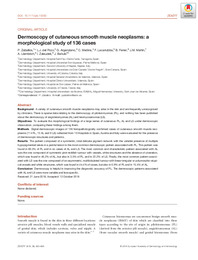Título :
Dermoscopy of cutaneous smooth muscle neoplasms: a morphological study of 136 cases |
Autor :
Zaballos, P.
Del Pozo, L.J.
Argenziano, G.
Medina, C.
Lacarrubia, F.
Ferrer, B.
Martin, J.M.
Llambrich, A.
Zalaudek, I.
Bañuls, J. |
Editor :
Wiley |
Departamento:
Departamentos de la UMH::Medicina Clínica |
Fecha de publicación:
2019-04 |
URI :
https://hdl.handle.net/11000/34993 |
Resumen :
Background: A variety of cutaneous smooth muscle neoplasms may arise in the skin and are frequently unrecognized by clinicians. There is sparse data relating to the dermoscopy of piloleiomyomas (PL), and nothing has been published about the dermoscopy of angioleiomyomas (AL) and leiomyosarcomas (LS).
Objectives: To evaluate the morphological findings of a large series of cutaneous PL, AL and LS under dermoscopic observation, comparing these findings among them.
Methods: Digital dermoscopic images of 136 histopathologically confirmed cases of cutaneous smooth muscle neoplasms (114 PL, 13 AL and 9 LS) collected from 10 Hospitals in Spain, Austria and Italy were evaluated for the presence of dermoscopic structures and patterns.
Results: The pattern composed of a symmetric, total delicate pigment network with the variable presence of multiple hypopigmented areas in a painful lesion is the most common dermoscopic pattern associated with PL. This pattern was found in 69.3% of PL and in no cases of AL and LS. The most common and characteristic pattern associated with AL was the one composed of symmetric pink-reddish tumour with vessels, white structures and the absence of ulceration, which was found in 46.2% of AL, but also in 3.5% of PL, and in 22.2% of LS. Finally, the most common pattern associated with LS was the one composed of an asymmetric, multilobulated tumour with linear-irregular or polymorphic-atypical vessels and white structures, which was found in 44.4% of cases, but also in 0.9% of PL and in 15.4% of AL.
Conclusion: Dermoscopy is helpful in improving the diagnostic accuracy of PL. The dermoscopic patterns associated with AL and LS were more variable and less specific.
|
Tipo de documento :
info:eu-repo/semantics/article |
Derechos de acceso:
info:eu-repo/semantics/openAccess
Attribution-NonCommercial-NoDerivatives 4.0 Internacional |
DOI :
10.1111/jdv.15392 |
Publicado en:
J Eur Acad Dermatol Venereol . 2019 Apr;33(4):693-699 |
Aparece en las colecciones:
Artículos Medicina Clínica
|
 La licencia se describe como: Atribución-NonComercial-NoDerivada 4.0 Internacional.
La licencia se describe como: Atribución-NonComercial-NoDerivada 4.0 Internacional.
.png)
